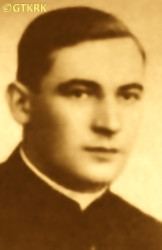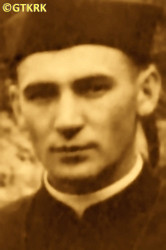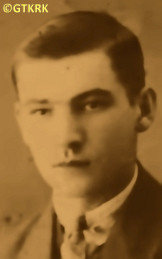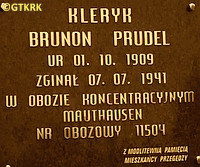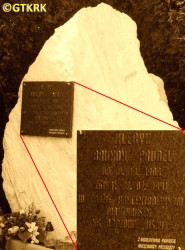Roman Catholic
St Sigismund parish
05-507 Słomczyn
85 Wiślana Str.
Konstancin deanery
Warsaw archdiocese, Poland
full list:
displayClick to display full list

searchClick to search full list by categories
wyświetlKliknij by wyświetlić pełną listę po polsku

szukajKliknij by przeszukać listę wg kategorii po polsku

Martyrology of the clergy — Poland
XX century (1914 – 1989)
personal data
surname
PRUDEL
forename(s)
Bruno (pl. Brunon)
forename(s)
versions/aliases
Bronislav (pl. Bronisław)
function
religious seminarian
creed
Latin (Roman Catholic) Church RCmore on
en.wikipedia.org
[access: 2014.09.21]
congregation
Congregation of the Holy Family Missionaries MSFmore on
fr.wikipedia.org
[access: 2014.09.21]
(i.e. Missionaries of the Holy Family)
diocese / province
MSF Polish Province
date and place
of death
07.07.1941

KL Gusen Iconcentration camp
today: n. St. Georgen an der Gusen, Sankt Georgen an der Gusen, Perg dist., Salzburg state, Austria
more on
en.wikipedia.org
[access: 2022.01.09]
alt. dates and places
of death
10.07.1941
details of death
After German invasion of Poland on 01.09.1939 (Russians invaded Poland 17 days later) and start of the World War II, due to the rapid German attack, the clerics in Bąblin (c. 30 km from the Polish–German border) left the house where they were studying, and on the night of 02‐03.09.1939, reached the Congregation's house in Kazimierz Biskupi n. Konin.
After a few days, some of them scattered and went home.
Himself remained in Kazimierz Biskupi (could have expected that his homeland had already been taken over by the Germans) and there, on 13.09.1939, after the monastery take over by the Germans, was interned (formally Germans set up an internment camp in the monastery on 09.11.1939).
Remained there till 21.05.1940 when was arrested by the Germans and moved to KL Posen concentration camp and next on 24.05.1940 transported to KL Dachau concentration camp.
Finally on 02.08.1940 transported to KL Gusen I concentration camp — part of KL Mauthausen‐Gusen concentration camps' complex — where he slaved in quarries and where perished (fell during a roll‐call).
prisoner camp's numbers
6928 (KL Mauthausen‐GusenClick to display the description), 11504Click to display source page (KL DachauClick to display the description)
cause of death
extermination: exhaustion and starvation
perpetrators
Germans
sites and events
KL Gusen IClick to display the description, KL Mauthausen‐GusenClick to display the description, KL DachauClick to display the description, DL ScheglinClick to display the description, 04‐05.1940 arrestsClick to display the description, IL BischofsfeldenClick to display the description, «Intelligenzaktion»Click to display the description, Ribbentrop‐MolotovClick to display the description, Pius XI's encyclicalsClick to display the description
date and place
of birth
01.10.1909

Przegędzatoday: Czerwionka‐Leszczyny gm., Rybnik pov., Silesia voiv., Poland
more on
en.wikipedia.org
[access: 2021.07.25]
parents
PRUDEL Constantine
🞲 ?, ? — 🕆 ?, ?

DUDA Monica
🞲 ?, ? — 🕆 ?, ?
religious vows
15.08.1935 (temporary)
08.09.1936 (permanent)
positions held
till 1939
student — Bąblintoday: Oborniki gm., Oborniki pov., Greater Poland voiv., Poland
more on
en.wikipedia.org
[access: 2021.12.18] ⋄ Theological Study (higher theological seminary), Congregation's house, Missionaries of the Holy Family MSF — 2nd year from 09.1939
student — Kruszewotoday: Ujście gm., Piła pov., Greater Poland voiv., Poland
more on
en.wikipedia.org
[access: 2021.07.18] ⋄ Philosophical Study (minor theological seminary), Congregation's house, Missionaries of the Holy Family MSF — prob.
c. 1934 – 1935
novitiate — Missionaries of the Holy Family MSF
1934
accession — Missionaries of the Holy Family MSF
sites and events
descriptions
KL Gusen I: German Germ. Konzentrationslager (Eng. concentration camp) KL „Grade III” (Germ. „Stufe III”), part of KL Mauthausen‐Gusen complex, intended for the „Incorrigible political enemies of the Reich”. The prisoners slaved at a nearby granite quarry, but also in local private companies: at SS guards houses' construction at a nearby Sankt Georgen for instance. Initially opened in 05.1940 as the „camp for Poles”, captured during the program of extermination of Polish intelligentsia («Intelligenzaktion»). Till the end most of the prisoners were Poles. Many Polish priests from the Polish regions incorporated in the Germany were brought there in 1940, after start of German occupation of Poland, from KL Sachsenhausen and KL Dachau concentration camps. (more on: en.wikipedia.orgClick to attempt to display webpage
[access: 2014.03.10])
KL Mauthausen‐Gusen: A large group of German Germ. Konzentrationslager (Eng. concentration camp) KL camps set up around the villages of Mauthausen and Gusen in Upper Austria, c. 30 km east of Linz, operational from 1938 till 05.1945. Over time it became of the largest labour camp complexes in the German‐controlled part of Europe encompassing four major camps concentration camps (KL Mauthausen, KL Gusen I, KL Gusen II and KL Gusen III) and more than 50 sub‐camps where inmates slaved in quarries — the granite extracted, previously used to pave the streets of Vienna, was intended for a complete reconstruction of major German towns according to the plans of the chief architect of National Socialist Germany, the Germ. Generalbauinspektor für die Reichshauptstadt (Eng. General Building Inspector for the Reich Capital) and from 1942 also, i.a. the Germ. Reichsminister für Bewaffnung und Munition (Eng. Reich Minister for Armaments and Ammunition), Albert Speer — munitions factories, mines, arms factories and Me 262 fighter‐plane assembly plants. The complex served the needs of the German war machine and also carried out extermination through labour. Initially did not have a its own gas chamber and the intended victims were mostly moved to the infamous euthanasia center in the Schloss Hartheim castle w Alkoven, 40.7 km east, or killed by lethal injection and cremated in the local crematorium. Later a van with the exhaust pipe connected to the inside shuttled between KL Mauthausen and KL Gusen. In 12.1941 a permanent gas chamber was built. C. 122,000‐360,000 of prisoners perished. Many Polish priests were held, including those captured during the program of extermination of Polish intelligentsia («Intelligenzaktion»). The camp complex was founded and run as a source for cheap labour for private enterprise. (more on: en.wikipedia.orgClick to attempt to display webpage
[access: 2014.03.10])
KL Dachau: KL Dachau in German Bavaria, set up in 1933, became the main German Germ. Konzentrationslager (Eng. concentration camp) KL for Catholic priests and religious during World War II: On c. 09.11.1940, Reichsführer‐SS Heinrich Himmler, head of the SS, Gestapo and German police, as a result of the Vatican's intervention, decided to transfer all clergymen detained in various concentration camps to KL Dachau camp. The first major transports took place on 08.12.1940. In KL Dachau Germans held approx. 3,000 priests, including 1,800 Poles. The priests were forced to slave labor in the Germ. „Die Plantage” — the largest herb garden in Europe, managed by the genocidal SS, consisting of many greenhouses, laboratory buildings and arable land, where experiments with new natural medicines were conducted — for many hours, without breaks, without protective clothing, no food. They slaved in construction, e.g. of camp's crematorium. In the barracks ruled hunger, freezing cold in the winter and suffocating heat during the summer, especially acute in 1941‐1942. Prisoners suffered from bouts of illnesses, including tuberculosis. Many were victims of murderous „medical experiments” — in 11.1942 c. 20 were given phlegmon injections; in 07.1942 to 05.1944 c. 120 were used by for malaria experiments. More than 750 Polish clerics where murdered by the Germans, some brought to TA Hartheim euthanasia centre set up in Schloss Hartheim in Austria and murdered in gas chambers. At its peak KL Dachau concentration camps’ system had nearly 100 slave labour sub‐camps located throughout southern Germany and Austria. There were c. 32,000 documented deaths at the camp, and thousands perished without a trace. C. 10,000 of the 30,000 inmates were found sick at the time of liberation, on 29.04.1945, by the USA troops… (more on: www.kz-gedenkstaette-dachau.deClick to attempt to display webpage
[access: 2013.08.10], en.wikipedia.orgClick to attempt to display webpage
[access: 2016.05.30])
DL Scheglin: Germ. Durchgangslager Scheglin (Eng. Transit Camp) — German camp in Szczeglin n. Mogilno, operational from 01.10.1939 till 15.09.1940. Germans kept there c. 4,600 Poles, forcing them to perform slave labour — before transporting them to concentration camps. Among others on 29.08.1940 Germans sent from DL Scheglin 188 Polish priests to KL Sachsenhausen concentration camp. Approx. 150 of those held in DL Scheglin were murdered — some in the camp itself, the others in an execution site in Świerkowice forest. (more on: www.dsh.waw.plClick to attempt to display webpage
[access: 2013.06.23])
04‐05.1940 arrests: On 02.04.1940 the German Reichssicherheitshauptamt (Eng. Reich Main Security Office) RSHA issued — as part of the extermination «Intelligenzaktion» action — regulation No. RSHA IV D 2 480/40, the content of which, although unknown, was referred to in the local regions implementing it as „preventive action to combat resistance of the Polish intelligentsia”. It covered all occupied Polish territories directly incorporated into Germany — thus, apart from the Germ. Generalgouvernement (Eng. General Governorate), among others — including Silesia, where it is known as «Intelligenzaktion Schlessien». During it, the Germans arrested and deported to concentration camps deep in Germany at least 10,697 Poles (according to other researchers, over 20,000), including 469 women to KL Ravensbrück, at least 7,824 men to KL Dachau and approximately 2,404 to KL Sachsenhausen. One of the commandants assessed the effectiveness of the action as follows: „There was an improvement in the behavior of the Polish population. The ostentatious use of the Polish language on the city streets has significantly weakened”. (more on: rcin.org.plClick to attempt to display webpage
[access: 2024.04.26])
IL Bischofsfelden: The Gestapo District Office in Poznań issued on 13.12.1939 executive instruction Ref. IIB No. 406/39 Tgb. No. 3045/39, ordering: „Based on the regulation of the Germ. Höherer SS‐ und Polizeiführer (Eng. Higher Commander of the SS and Police) [of the German province of Warthegau (Eng. Greater Poland)] of 12.11.1939 [SS‐Gruppenführer Wilhelm Koppe], apart from Poles and Jews, also Catholic clergy will be expelled. Action against this group of people should be carried out in such a way that internment and transport are separate […] C. 80% of Catholic clergy are expected to be expelled. The selection based on political threat posed. Internees cannot be placed in regular transit camps due to the possibility of international protest. Catholic clergy should be interned in men's monasteries and held there till mass transportation out”. And so in the Missionary of the Holy Family MSF monastery, in Kazimierz Biskupi village, near Konin, the Germans set up the IL Bischofsfelden transit Germ. „Internierungslager” (Eng. „Internment camp”) for altogether 42 Polish Catholic priests, mainly from Greater Poland (Wielkopolski) — activists of Catholic organizations, canons of the Poznań cathedral chapter, Dominican and Conventual Franciscan friars from Poznań. The camp operated from 09.11.1939 to 26.08.1940. Some of the priests were released by Germans, the rest being transported to German concentration camps, where 8 of them perished. After the liquidation of the camp, the Germans converted the church and monastery into a granary. (more on: regionwielkopolska.plClick to attempt to display webpage
[access: 2013.10.05])
«Intelligenzaktion»: (Eng. „Action Intelligentsia”) — extermination program of Polish elites, mainly intelligentsia, executed by the Germans right from the start of the occupation in 09.1939 till around 05.1940, mainly on the lands directly incorporated into Germany but also in the so‐called Germ. Generalgouvernement (Eng. General Governorate) where it was called «AB‐aktion». During the first phase right after start of German occupation of Poland implemented as Germ. Unternehmen „Tannenberg” (Eng. „Tannenberg operation”) — plan based on proscription lists of Poles worked out by (Germ. Sonderfahndungsbuch Polen), regarded by Germans as specially dangerous to the German Reich. List contained names of c. 61,000 Poles. Altogether during this genocide Germans methodically murdered c. 50,000 teachers, priests, landowners, social and political activists and retired military. Further 50,000 were sent to concentration camps where most of them perished. (more on: en.wikipedia.orgClick to attempt to display webpage
[access: 2014.10.04])
Ribbentrop‐Molotov: Genocidal Russian‐German alliance pact between Russian leader Joseph Stalin and German leader Adolf Hitler signed on 23.08.1939 in Moscow by respective foreign ministers, Mr. Vyacheslav Molotov for Russia and Joachim von Ribbentrop for Germany. The pact sanctioned and was the direct cause of joint Russian and German invasion of Poland and the outbreak of the World War II in 09.1939. In a political sense, the pact was an attempt to restore the status quo ante before 1914, with one exception, namely the „commercial” exchange of the so‐called „Kingdom of Poland”, which in 1914 was part of the Russian Empire, fore Eastern Galicia (today's western Ukraine), in 1914 belonging to the Austro‐Hungarian Empire. Galicia, including Lviv, was to be taken over by the Russians, the „Kingdom of Poland” — under the name of the General Governorate — Germany. The resultant „war was one of the greatest calamities and dramas of humanity in history, for two atheistic and anti‐Christian ideologies — national and international socialism — rejected God and His fifth Decalogue commandment: Thou shall not kill!” (Abp Stanislav Gądecki, 01.09.2019). The decisions taken — backed up by the betrayal of the formal allies of Poland, France and Germany, which on 12.09.1939, at a joint conference in Abbeville, decided not to provide aid to attacked Poland and not to take military action against Germany (a clear breach of treaty obligations with Poland) — were on 28.09.1939 slightly altered and made more precise when a treaty on „German‐Russian boundaries and friendship” was agreed by the same murderous signatories. One of its findings was establishment of spheres of influence in Central and Eastern Europe and in consequence IV partition of Poland. In one of its secret annexes agreed, that: „the Signatories will not tolerate on its respective territories any Polish propaganda that affects the territory of the other Side. On their respective territories they will suppress all such propaganda and inform each other of the measures taken to accomplish it”. The agreements resulted in a series of meeting between two genocidal organization representing both sides — German Gestapo and Russian NKVD when coordination of efforts to exterminate Polish intelligentsia and Polish leading classes (in Germany called «Intelligenzaktion», in Russia took the form of Katyń massacres) where discussed. Resulted in deaths of hundreds of thousands of Polish intelligentsia, including thousands of priests presented here, and tens of millions of ordinary people,. The results of this Russian‐German pact lasted till 1989 and are still in evidence even today. (more on: en.wikipedia.orgClick to attempt to display webpage
[access: 2015.09.30])
Pius XI's encyclicals: Facing the creation of two totalitarian systems in Europe, which seemed to compete with each other, though there were more similarities than contradictions between them, Pope Pius XI issued in 03.1937 (within 5 days) two encyclicals. In the „Mit brennender Sorge” (Eng. „With Burning Concern”) published on 14.03.1938, condemned the national socialism prevailing in Germany. The Pope wrote: „Whoever, following the old Germanic‐pre‐Christian beliefs, puts various impersonal fate in the place of a personal God, denies the wisdom of God and Providence […], whoever exalts earthly values: race or nation, or state, or state system, representatives of state power or other fundamental values of human society, […] and makes them the highest standard of all values, including religious ones, and idolizes them, this one […] is far from true faith in God and from a worldview corresponding to such faith”. On 19.03.1937, published „Divini Redemptoris” (Eng. „Divine Redeemer”), in which criticized Russian communism, dialectical materialism and the class struggle theory. The Pope wrote: „Communism deprives man of freedom, and therefore the spiritual basis of all life norms. It deprives the human person of all his dignity and any moral support with which he could resist the onslaught of blind passions […] This is the new gospel that Bolshevik and godless communism preaches as a message of salvation and redemption of humanity”… Pius XI demanded that the established human law be subjected to the natural law of God , recommended the implementation of the ideal of a Christian state and society, and called on Catholics to resist. Two years later, National Socialist Germany and Communist Russia came together and started World War II. (more on: www.vatican.vaClick to attempt to display webpage
[access: 2023.05.28], www.vatican.vaClick to attempt to display webpage
[access: 2023.05.28])
sources
personal:
www.gusen.org.plClick to attempt to display webpage
[access: 2012.11.23], www.msf.opoka.org.plClick to attempt to display webpage
[access: 2012.12.28], silesia.edu.plClick to attempt to display webpage
[access: 2019.05.30], www.gedenkstaetten.atClick to attempt to display webpage
[access: 2018.10.04]
bibliographical:
„A martyrology of Polish clergy under German occupation, 1939‐1945”, Fr Szołdrski Vladislaus CSSR, Rome 1965
original images:
silesia.edu.plClick to attempt to display webpage
[access: 2019.05.30], misjonarzemsf.plClick to attempt to display webpage
[access: 2022.09.17], misjonarzemsf.plClick to attempt to display webpage
[access: 2022.09.17], misjonarzemsf.plClick to attempt to display webpage
[access: 2022.09.17], silesia.edu.plClick to attempt to display webpage
[access: 2019.05.30]
LETTER to CUSTODIAN/ADMINISTRATOR
If you have an Email client on your communicator/computer — such as Mozilla Thunderbird, Windows Mail or Microsoft Outlook, described at WikipediaPatrz:
en.wikipedia.org, among others — try the link below, please:
LETTER to CUSTODIAN/ADMINISTRATORClick and try to call your own Email client
If however you do not run such a client or the above link is not active please send an email to the Custodian/Administrator using your account — in your customary email/correspondence engine — at the following address:

giving the following as the subject:
MARTYROLOGY: PRUDEL Bruno
To return to the biography press below:
 Click to return to biography
Click to return to biography








